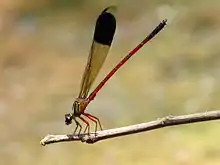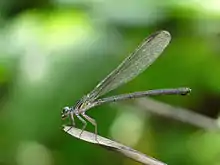Euphaeidae
The Euphaeidae are a family of damselflies in the order Odonata sometimes called Epallaginidae. They are commonly known as gossamerwings. It is a small family of damselflies with around 70 species. They commonly occur in Old World tropics. They are large and mostly metallic-coloured. They look similar to species of damselflies in the family Calopterygidae.[2]
| Euphaeidae | |
|---|---|
 | |
| Euphaea fraseri, male | |
 | |
| Euphaea fraseri, female | |
| Scientific classification | |
| Kingdom: | Animalia |
| Phylum: | Arthropoda |
| Class: | Insecta |
| Order: | Odonata |
| Suborder: | Zygoptera |
| Superfamily: | Calopterygoidea |
| Family: | Euphaeidae Jacobson & Bianchi, 1905[1] |
| Genera | |
| |
The larvae have seven pairs of supplementary gills along the abdomen in addition to the usual three sac-like gills at the tip of the abdomen. Adults have the fore- and hindwings of equal length, barely petiolate and a long pterostigma that is broader in the hindwing. Adults have close veins and numerous antenodals (15-38), and most breed in forest streams.[3][4]
References
- Bechly, G. (1998). "New Fossil Damselflies from Baltic Amber, with Description of a New Species, a Redescription of Litheuphaea Carpenteri Fraser, and a Discussion on the Phylogeny of Epallagidae (zygoptera: Caloptera)". International Journal of Odonatology. 1 (1): 33–63. doi:10.1080/13887890.1998.9748092. ISSN 1388-7890.
- Martin Schorr; Dennis Paulson. "World Odonata List". University of Puget Sound. Retrieved 12 Oct 2018.
- Hämäläinen, M. (2003). "Cryptophaea, a new euphaeid genus and three new species of Caloptera damselflies from Thailand (Odonata: Euphaeidae, Calopterygidae)". Zool. Med. Leiden. 77 (25): 441–454.
- Lok, A. F. S. L. and A. G. Orr (2009). "The biology of Euphaea impar Selys (Odonata: Euphaeidae) in Singapore" (PDF). Nature in Singapore. 2: 135–140.
This article is issued from Wikipedia. The text is licensed under Creative Commons - Attribution - Sharealike. Additional terms may apply for the media files.